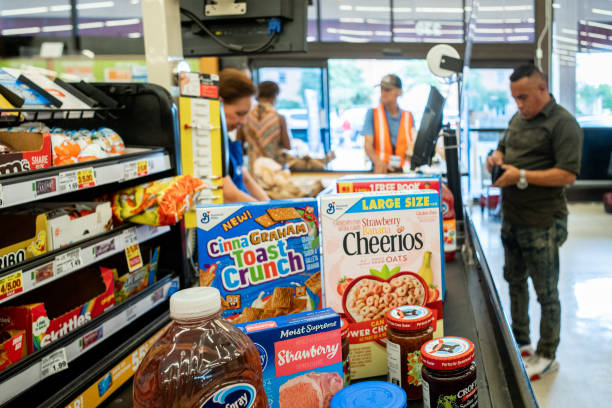25 Essential College Grocery List for Students in 2023 | Copy Ours
As a college student, managing your diet and maintaining a healthy lifestyle can be a challenging task. With a busy schedule, limited cooking facilities, and a tight budget, it’s crucial to have a college grocery list for shopping wisely.
Sometimes, students can be indecisive when it comes to choice and priority of what they need for school. It is the purpose of this college grocery list to guide the student in getting the best and most needed grocery for consumption and use.
In this blog post, we present a comprehensive 25 essential college grocery list of items for college students in 2023. These items are not only convenient but also provide essential nutrients to support your physical and mental well-being.
What is a Grocery?
A grocery refers to a store or a shop where various food items and household products are sold to the general public.
It is a retail establishment that specializes in providing a wide range of edible goods, including fresh produce, dairy products, meat, poultry, seafood, grains, canned and packaged goods, beverages, snacks, and more.
Groceries also typically offer non-food items such as cleaning supplies, personal care products, and sometimes even household appliances.
Grocery stores are essential for people to purchase the everyday items they need to sustain their households.
They are commonly found in neighborhoods and communities, ranging from small local markets to large supermarket chains.
Customers can visit grocery stores to browse and select the items they want to buy, which are typically displayed on shelves or refrigerated sections.
In recent years, the rise of online grocery shopping has allowed customers to order groceries through websites or mobile apps for home delivery or in-store pickup.
The Benefit of Groceries for Students
Groceries can provide numerous benefits for students. Here are some of the key advantages:
1. Cost savings
Buying groceries and cooking meals at home is often more cost-effective than eating out or relying on convenience foods. Students who purchase groceries can plan their meals, buy ingredients in bulk, and take advantage of sales or discounts, helping them save money in the long run.
2. Healthier choices
By having access to groceries, students can make healthier food choices. They can purchase fresh produce, lean proteins, whole grains, and other nutritious ingredients to prepare balanced meals. This can contribute to improved energy levels, focus, and overall well-being.
3. Customization and dietary preferences
Grocery shopping allows students to personalize their meals according to their dietary preferences or restrictions.
Whether they follow a specific diet (e.g., vegetarian, vegan, gluten-free) or have individual taste preferences, buying groceries enables them to have control over their food choices and create meals that align with their needs.
4. Learning opportunity
Grocery shopping and cooking provide valuable life skills. Students can develop their knowledge about nutrition, food preparation, and meal planning.
They can experiment with different recipes, learn to cook on a budget and enhance their culinary skills, which are valuable skills that can be carried into adulthood.
5. Time management
Buying groceries and preparing meals at home can help students manage their time more efficiently.
With some planning and meal prepping, they can have ready-to-eat or easily prepared meals throughout the week, saving time on deciding where to eat, waiting in line, or waiting for food to be delivered.
25 Essential College Grocery List for Students in 2023

1. Whole Grain Cereal
Start your day with a nutritious breakfast by choosing whole-grain cereals that are high in fiber and low in sugar. Look for options like oatmeal, whole grain flakes, or bran cereals.
Whole grain cereals are a nutritious and popular breakfast option among many individuals, including students. Here are some key benefits of consuming whole-grain cereals:
- Nutritional value: Whole grain cereals are a good source of essential nutrients such as dietary fiber, vitamins, minerals, and antioxidants. They often contain higher amounts of fiber, B vitamins, and minerals compared to refined grain cereals.
- Energy and satiety: Whole grain cereals provide a good source of complex carbohydrates, which are the body’s primary source of energy.
2. Fresh Fruits
Fresh fruits are delicious and nutritious natural foods that are harvested from plants when they are fully ripened. They are a rich source of vitamins, minerals, fiber, and antioxidants, which are essential for maintaining good health.
Fresh fruits come in a wide variety of colors, flavors, and textures, making them a versatile ingredient in various culinary creations.
Pack your dorm room with fresh fruits like apples, bananas, oranges, and berries. They are rich in vitamins, fiber, and antioxidants, providing a healthy snack option.
3. Greek Yogurt
Greek yogurt is a type of yogurt that has been strained to remove most of the whey, resulting in a thicker and creamier texture compared to regular yogurt.
It has been a staple in Greek cuisine for centuries and has gained popularity worldwide in recent years due to its rich and tangy flavor, as well as its nutritional benefits.
Greek yogurt is an excellent source of protein and calcium. It can be enjoyed on its own or mixed with fruits and granola for a quick and fulfilling snack.
4. Nut Butter
Nut butter is a spreadable paste made from ground nuts. It is similar in consistency to traditional butter or spreads like peanut butter and is commonly used as a topping, ingredient, or filling in various foods.
The most popular types of nut butter include peanut butter, almond butter, cashew butter, and hazelnut butter.
These nut kinds of butter are typically made by roasting the nuts, grinding them into a smooth or slightly chunky paste, and sometimes adding a small amount of oil or sweetener for flavor and texture.
Nut butter is often enjoyed on bread, crackers, or fruits, and it can also be incorporated into recipes for sauces, smoothies, baked goods, and other dishes.
Peanut butter or almond butter can be a versatile and healthy addition to your grocery list. Spread it on bread, add it to smoothies, or use it as a dip for fruits and veggies.
Whole Wheat Bread: Opt for whole wheat or multigrain bread instead of white bread. It’s higher in fiber and essential nutrients, making it a healthier choice for sandwiches or toast.
5. Eggs
Eggs are a budget-friendly and protein-packed food item. They can be cooked in various ways, such as boiled, scrambled, or made into omelets.
6. Fresh Vegetables
Stock up on a variety of fresh vegetables like spinach, bell peppers, carrots, and tomatoes. They can be added to salads, sandwiches, or stir-fries, providing essential vitamins and minerals.
7. Frozen Vegetables
Keep a bag of frozen vegetables in your freezer as a backup option. They are convenient, cost-effective, and can be quickly cooked to add to your meals.
8. Chicken or Tofu
In looking out for grocery items a student should also include a source of lean protein in their grocery list, such as boneless chicken breasts or tofu.
They can be grilled, baked, or stir-fried, providing versatility for different dishes.
9. Rice or Quinoa
Rice or quinoa can serve as a base for many meals. They are easy to cook and can be paired with vegetables, proteins, or sauces to create a balanced and filling dish.
In selecting a college grocery list, rice should be at the top of the list because of its multi-use.
10. Canned Beans
Canned beans are a popular and convenient food product that consists of cooked beans that have been preserved in a can with liquid.
They are widely available in grocery stores and come in various types, including kidney beans, black beans, pinto beans, chickpeas (garbanzo beans), and more.
Canned beans, such as black beans, chickpeas, or kidney beans, are a convenient and affordable source of plant-based protein. They can be added to salads, wraps, or used to make vegetarian chili.
11. Pasta
Pasta is a staple for college students due to its versatility and ease of preparation. Opt for whole wheat or gluten-free varieties and pair it with homemade sauces or vegetables for a nutritious meal.
12. Canned Tuna or Salmon
Both Canned Tuna and Salmon are popular choices for convenient and nutritious seafood options. The choice between canned tuna and salmon ultimately comes down to personal preference and dietary considerations.
Canned tuna or salmon can be a great source of omega-3 fatty acids and protein. They are perfect for making quick sandwiches, salads, or wraps.
13. Milk or Plant-Based Milk
Choose low-fat or plant-based milk options like almond, soy, or oat milk. They can be used in cereal, smoothies, or as a standalone beverage.
14. Cheese
Cheese can add flavor and protein to your meals. Opt for varieties like cheddar, mozzarella, or feta, and use them in sandwiches, salads, or as a topping for pasta dishes.
15. Nuts and Seeds
Stock up on a variety of nuts and seeds like almonds, walnuts, chia seeds, or flaxseeds. They make for a healthy snack, can be added to yogurt or cereal, and provide essential healthy fats.
16. Granola or Energy Bars
Keep a stash of granola bars or energy bars in your backpack for quick and nutritious snacks on the go. Look for options with minimal added sugars and whole ingredients.
17. Olive Oil
Olive oil is a healthier cooking oil alternative. Use it for sautéing vegetables or as a dressing for salads to add healthy fats to your meals.
18. Herbs and Spices
Build a collection of herbs and spices like basil, oregano, cinnamon, and paprika. They can elevate the flavors of your dishes without adding excessive salt or calories.
19. Instant Oatmeal
Instant oatmeal is a convenient and nutritious option for a quick breakfast. Choose plain or low-sugar varieties and customize them with fruits, nuts, or seeds.
20. Dark Chocolate
Dark chocolate can be a satisfying treat while also providing antioxidants. Look for options with a higher cocoa content (70% or more) and enjoy it in moderation.
21. Hummus
Hummus is a delicious and protein-rich dip made from chickpeas. It can be enjoyed with fresh veggies, and pita bread, or used as a spread in sandwiches.
22. Green Tea
Keep a box of green tea bags in your pantry. Green tea is known for its antioxidant properties and can be a healthier alternative to sugary beverages.
23. Sparkling Water
Stay hydrated with sparkling water, which can be a refreshing and zero-calorie choice. Add a slice of lemon or cucumber for a burst of flavor.
24. Multivitamins
While a balanced diet should provide most of the necessary nutrients, taking a multivitamin can help fill in any gaps and ensure you’re meeting your nutritional needs.
What Essential Items Should be Included in a College Grocery List?
A college grocery list typically includes a variety of essential items that can help students meet their nutritional needs while also considering convenience and budget.
- What pantry staples should I include? Pantry staples are long-lasting items that can be used in various recipes. Some common pantry staples include rice, pasta, canned beans, canned vegetables, cooking oil, spices, condiments (such as ketchup and mustard), and baking essentials like flour and sugar.
- What fresh produce should I buy? Fresh fruits and vegetables are important for a well-balanced diet. Some commonly purchased fruits include apples, bananas, oranges, and berries. Popular vegetables include lettuce, spinach, tomatoes, cucumbers, carrots, and bell peppers. It’s a good idea to choose produce that can be eaten raw or cooked depending on your preferences and cooking facilities.
- What protein sources should I consider? Protein is an important nutrient, and there are several options for college students. Some commonly chosen protein sources include chicken breasts, ground beef or turkey, eggs, tofu, canned tuna or salmon, and plant-based alternatives like beans, lentils, and chickpeas.
How Can I Create a College Grocery List on a Budget?
Many college students are on a tight budget, so it’s important to plan a grocery list that is both nutritious and affordable.
- How can I save money on groceries? Look for sales and discounts at your local grocery store, compare prices between different stores, and consider using coupons or store loyalty programs. Buying in bulk for non-perishable items like rice or pasta can also save money in the long run. Additionally, opting for generic or store-brand products instead of name brands can often provide similar quality at a lower cost.
- Are there affordable alternatives for fresh produce? Fresh produce can be expensive, but there are ways to save money. Consider buying seasonal fruits and vegetables, as they tend to be more affordable and offer better quality. Frozen fruits and vegetables are also a cost-effective option and can be just as nutritious as fresh produce.
- What are some inexpensive protein sources? Protein can be a significant expense, but there are affordable options available. Canned tuna or beans, eggs, and cheaper cuts of meat (such as chicken thighs instead of chicken breasts) are often more budget-friendly. Plant-based protein sources like lentils, tofu, and legumes are also cost-effective alternatives.
How can I plan a college grocery list for healthy eating?
Maintaining a healthy diet in college is crucial for overall well-being and academic performance.
- What should I include for balanced meals? Aim to include a variety of food groups in your grocery list. Include whole grains like whole wheat bread or quinoa, lean proteins like chicken or fish, plenty of fruits and vegetables, and healthy fats like avocados or nuts. Also, consider adding dairy products like milk or yogurt, or plant-based alternatives like almond milk or soy yogurt.
- How can I incorporate snacks for healthy eating? Snacks are important for keeping energy levels stable throughout the day. Include nutritious snacks like fresh fruits, pre-cut vegetables with hummus, yogurt cups, mixed nuts, or granola bars made with whole ingredients. Avoid excessive sugary or processed snacks and opt for healthier options instead.
- Any tips for meal planning? Meal planning can help you eat healthy and save time. Plan your meals for the week and create a corresponding grocery list. Consider preparing large batches of meals that can be portioned and refrigerated or frozen for later use. This can save money and
Conclusion
Navigating the world of grocery shopping as a college student can be overwhelming, but with this comprehensive 25 essential college grocery list of items, you’ll be well-equipped to make smart food choices.
Prioritize fresh fruits, vegetables, lean proteins, whole grains, and healthy snacks while also considering your budget and convenience.
Remember, maintaining a well-rounded diet will not only support your physical health but also boost your energy levels and cognitive function, ultimately enhancing your college experience.






